英语国家社会与文化New zealand新西兰
主要英语国家社会与文化课程要求及考评
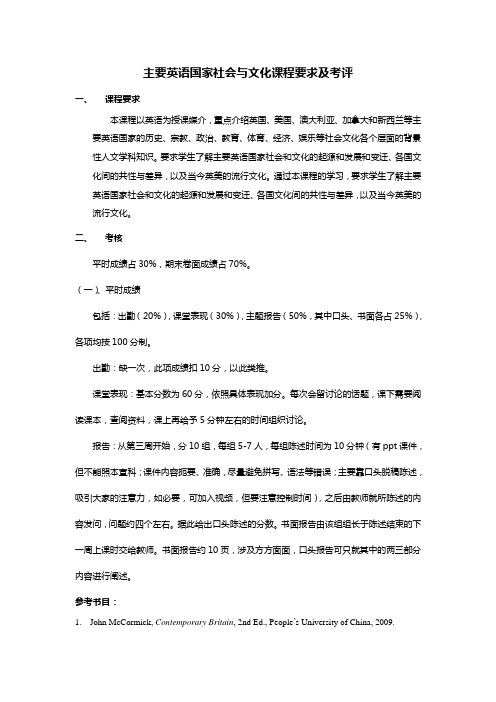
主要英语国家社会与文化课程要求及考评一、课程要求本课程以英语为授课媒介,重点介绍英国、美国、澳大利亚、加拿大和新西兰等主要英语国家的历史、宗教、政治、教育、体育、经济、娱乐等社会文化各个层面的背景性人文学科知识。
要求学生了解主要英语国家社会和文化的起源和发展和变迁、各国文化间的共性与差异,以及当今英美的流行文化。
通过本课程的学习,要求学生了解主要英语国家社会和文化的起源和发展和变迁、各国文化间的共性与差异,以及当今英美的流行文化。
二、考核平时成绩占30%,期末卷面成绩占70%。
(一)、平时成绩包括:出勤(20%),课堂表现(30%),主题报告(50%,其中口头、书面各占25%),各项均按100分制。
出勤:缺一次,此项成绩扣10分,以此类推。
课堂表现:基本分数为60分,依照具体表现加分。
每次会留讨论的话题,课下需要阅读课本,查阅资料,课上再给予5分钟左右的时间组织讨论。
报告:从第三周开始,分10组,每组5-7人,每组陈述时间为10分钟(有ppt课件,但不能照本宣科;课件内容扼要、准确,尽量避免拼写、语法等错误;主要靠口头脱稿陈述,吸引大家的注意力,如必要,可加入视频,但要注意控制时间),之后由教师就所陈述的内容发问,问题约四个左右。
据此给出口头陈述的分数。
书面报告由该组组长于陈述结束的下一周上课时交给教师。
书面报告约10页,涉及方方面面,口头报告可只就其中的两三部分内容进行阐述。
参考书目:1.John McCormick, Contemporary Britain, 2nd Ed., People’s University of China, 2009.2.Russell Duncan & Joseph Goddard, Contemporary America, 2nd ed. People’s University ofChina, 2009.3.Chen Likai, Stories in American History, Nanjing University, 2007.4.Rod Lawrence ed. Contemporary British Culture and Society, Shanghai Foreign LanguageEducation Press, 2006.5.Zhou Jingqiong ed. Contemporary American Culture and Society, Shanghai ForeignLanguage Education Press, 2006.6.钱乘旦,许洁明著,英国通史,上海社会科学院出版社,2002年。
英语国家社会与文化入门下册PPT教学课件-U1
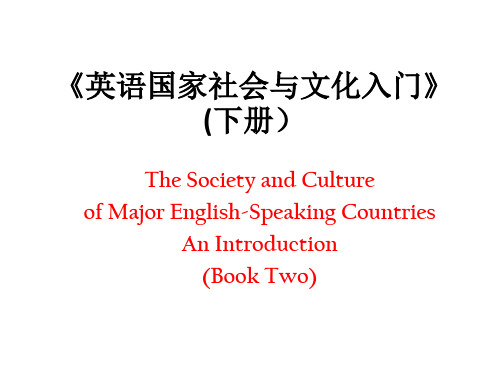
Māoritanga
-the iwi: a Māori tribe, the main social organization in Māori society;
Left: Auckland, the largest city of New Zealand; Right: Wellington’s Beehive, the national symbol of executive power
• Climate and Wildlife
-the southern temperate latitudes midway between the Equator and the South Pole; -maritime climate; -seasons opposite to the Northern Hemisphere; - isolated from the rest of the world for 80 million years, New Zealand developed unique flora and fauna. -80% of the trees, ferns and flowering plants are endemic (found only in New Zealand); -6.2 million hectares of native forest
I. Land and Environment
• Georgraphy: “Aotearoa”--“Land of the long white cloud”
大学英语英语国家概况 New Zealand
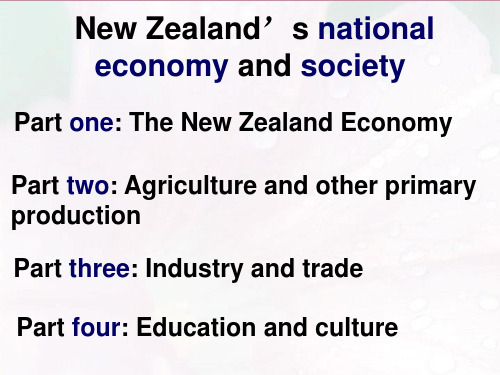
Green-lipped mussel
(绿唇蚌)
Oyster
(杜蛎)
Trout (鳟鱼 )
Salmon
Industry and trade
Miss Wu
Industry
1. In recent years New Zealand has developed its agriculture and manufacturing industries to suit the needs of the international markets.
New Zealand’s national economy and society
Part one: The New Zealand Economy
Part two: Agriculture and other primary production
Part three: Industry and trade
Service industries-are the main growth points of the national economy.Especially its tourism,which has a sgnificant growth prospect dues to the good ecological environment.Meanwhile,its banking system provides all the financial service. 409
The capital of sailing boat: Auckland
Trade
• Heavily dependent on external trade.
• In 2012 external trade amounted to 93.283 billion New Zealand dollars, of which exports 46.064billion New Zealand dollars, imports 47.219 billion New Zealand dollars
英语国家社会文化
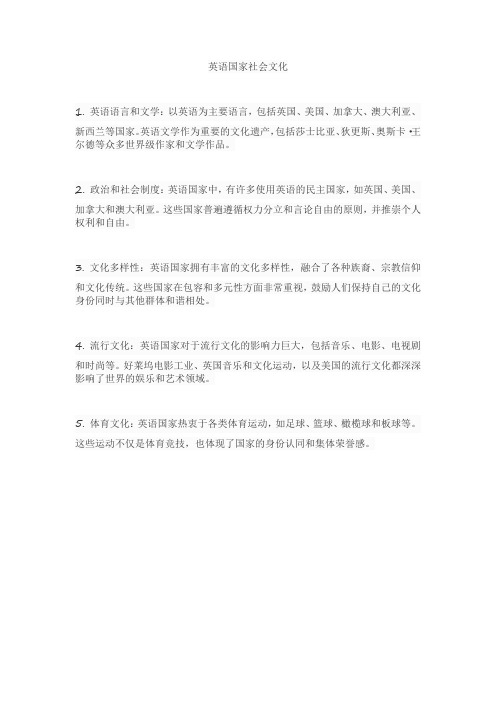
英语国家社会文化
1. 英语语言和文学:以英语为主要语言,包括英国、美国、加拿大、澳大利亚、
新西兰等国家。
英语文学作为重要的文化遗产,包括莎士比亚、狄更斯、奥斯卡·王尔德等众多世界级作家和文学作品。
2. 政治和社会制度:英语国家中,有许多使用英语的民主国家,如英国、美国、
加拿大和澳大利亚。
这些国家普遍遵循权力分立和言论自由的原则,并推崇个人权利和自由。
3. 文化多样性:英语国家拥有丰富的文化多样性,融合了各种族裔、宗教信仰
和文化传统。
这些国家在包容和多元性方面非常重视,鼓励人们保持自己的文化身份同时与其他群体和谐相处。
4. 流行文化:英语国家对于流行文化的影响力巨大,包括音乐、电影、电视剧
和时尚等。
好莱坞电影工业、英国音乐和文化运动,以及美国的流行文化都深深影响了世界的娱乐和艺术领域。
5. 体育文化:英语国家热衷于各类体育运动,如足球、篮球、橄榄球和板球等。
这些运动不仅是体育竞技,也体现了国家的身份认同和集体荣誉感。
英语国家社会与文化入门-简答题
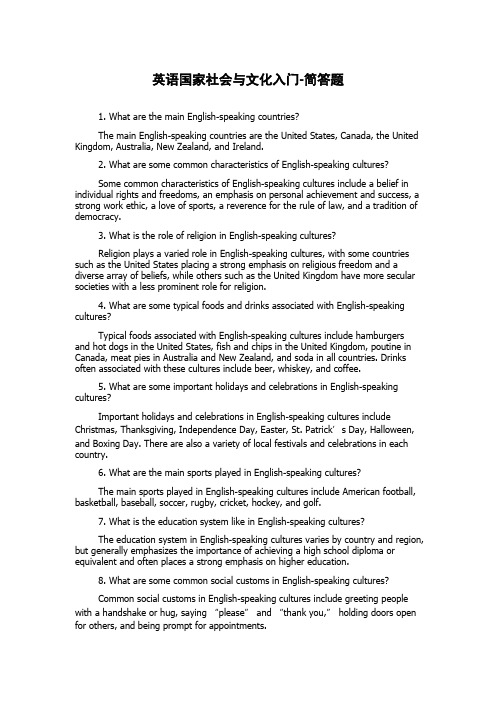
英语国家社会与文化入门-简答题1. What are the main English-speaking countries?The main English-speaking countries are the United States, Canada, the United Kingdom, Australia, New Zealand, and Ireland.2. What are some common characteristics of English-speaking cultures?Some common characteristics of English-speaking cultures include a belief in individual rights and freedoms, an emphasis on personal achievement and success, a strong work ethic, a love of sports, a reverence for the rule of law, and a tradition of democracy.3. What is the role of religion in English-speaking cultures?Religion plays a varied role in English-speaking cultures, with some countries such as the United States placing a strong emphasis on religious freedom and a diverse array of beliefs, while others such as the United Kingdom have more secular societies with a less prominent role for religion.4. What are some typical foods and drinks associated with English-speaking cultures?Typical foods associated with English-speaking cultures include hamburgers and hot dogs in the United States, fish and chips in the United Kingdom, poutine in Canada, meat pies in Australia and New Zealand, and soda in all countries. Drinks often associated with these cultures include beer, whiskey, and coffee.5. What are some important holidays and celebrations in English-speaking cultures?Important holidays and celebrations in English-speaking cultures include Christmas, Thanksgiving, Independence Day, Easter, St. Patrick’s Day, Halloween, and Boxing Day. There are also a variety of local festivals and celebrations in each country.6. What are the main sports played in English-speaking cultures?The main sports played in English-speaking cultures include American football, basketball, baseball, soccer, rugby, cricket, hockey, and golf.7. What is the education system like in English-speaking cultures?The education system in English-speaking cultures varies by country and region, but generally emphasizes the importance of achieving a high school diploma or equivalent and often places a strong emphasis on higher education.8. What are some common social customs in English-speaking cultures?Common social customs in English-speaking cultures include greeting people with a handshake or hug, saying “please” and “thank you,” holding doors open for others, and being prompt for appointments.9. What are some common values shared by English-speaking cultures?Common values shared by English-speaking cultures include honesty, respect for others, hard work, and a belief in the importance of education.10. What role does the media play in English-speaking cultures?The media plays an important role in English-speaking cultures, providing information and entertainment to people. There are a variety of media outlets, including print, television, radio, and online sources.。
英语国家社会与文化入门
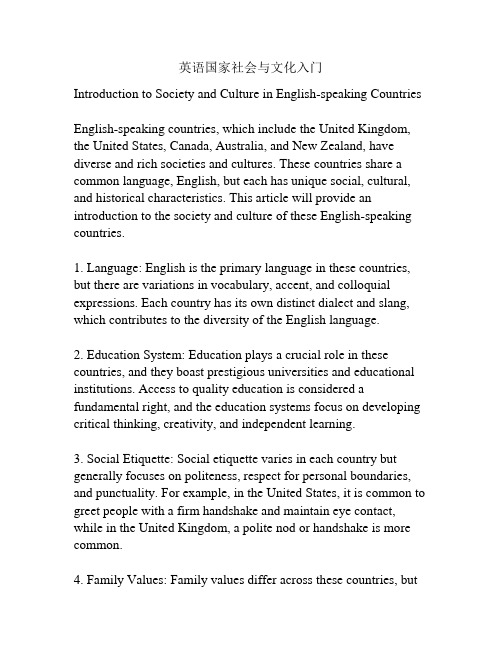
英语国家社会与文化入门Introduction to Society and Culture in English-speaking CountriesEnglish-speaking countries, which include the United Kingdom, the United States, Canada, Australia, and New Zealand, have diverse and rich societies and cultures. These countries share a common language, English, but each has unique social, cultural, and historical characteristics. This article will provide an introduction to the society and culture of these English-speaking countries.1. Language: English is the primary language in these countries, but there are variations in vocabulary, accent, and colloquial expressions. Each country has its own distinct dialect and slang, which contributes to the diversity of the English language.2. Education System: Education plays a crucial role in these countries, and they boast prestigious universities and educational institutions. Access to quality education is considered a fundamental right, and the education systems focus on developing critical thinking, creativity, and independent learning.3. Social Etiquette: Social etiquette varies in each country but generally focuses on politeness, respect for personal boundaries, and punctuality. For example, in the United States, it is common to greet people with a firm handshake and maintain eye contact, while in the United Kingdom, a polite nod or handshake is more common.4. Family Values: Family values differ across these countries, butthe concept of nuclear family is prevalent. Family gatherings and celebrations are important, and family members maintain close relationships. However, there is an increasing trend towards more independent lifestyles and individualism, especially in urban areas.5. Cuisine: The cuisine in English-speaking countries reflects their historical influences and multicultural societies. In the United Kingdom, traditional dishes include fish and chips, roast beef, and afternoon tea. The United States is known for its fast food culture, barbecues, and diverse food options influenced by various cultures. Australia and New Zealand are famous for their seafood, meat pies, and barbecues, while Canada offers a mix of traditional British and French cuisine.6. Sports: Sports play a significant role in the cultures of these countries. Football (soccer), rugby, cricket, and basketball are popular in the United Kingdom. The United States is known for American football, basketball, baseball, and ice hockey. Australia's passion lies in Australian rules football, cricket, and rugby, while Canada excels in ice hockey, lacrosse, and Canadian football.7. Arts and Entertainment: These countries have vibrant art scenes and are known for their contributions to literature, music, and film. British authors like William Shakespeare and Jane Austen have had a significant impact on English literature. Hollywood dominates the film industry, while the music scene in the United States has shaped popular music worldwide. Australia and New Zealand have produced internationally renowned actors, musicians, and writers.8. Festivals and Celebrations: Each country has its own national and cultural festivals and celebrations. In the United Kingdom, notable events include Bonfire Night, Christmas, and the Changing of the Guard at Buckingham Palace. The United States celebrates Thanksgiving, Independence Day, and Halloween, among others. Australia and New Zealand celebrate ANZAC Day, Australia Day, Waitangi Day, and various multicultural festivals. Canada observes Canada Day and celebrates cultural festivities like the Calgary Stampede.These are just a few facets of the society and culture in English-speaking countries. Exploring these countries in depth would reveal even more fascinating aspects of their history, traditions, and contemporary influences.。
英语国家社会与文化
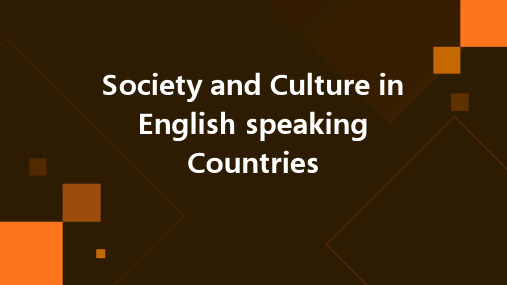
The population of English speaking counties is diverse, with a combined population of over 500 million people The majority of the population in these counties is urbanized and concentrated in major cities
Constitutional Monarchy
Other English speaking counties, such as the United States, India, and Australia, have a replication system with a presence as the head of state The political system in these counties is based on democratic principles with selected representatives
Geographic location and population
The early history of English speaking countries is marketed by colonization and settlement by the British, Irish, and other European nations This period also saw the development of the English language as it is known today
Education system structure
英语国家社会与文化入门第一单元 New Zealand
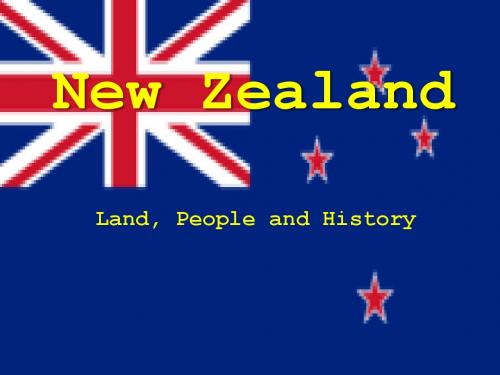
New Zealand
Land, People and History
Geography and Land
a. Situated in the southwest Pacific Ocean. b. New Zealand is made up of two main landmasses ,the North Island and South Island ,separated by Cook Strait. c.New Zealand is similar in size to Japan or British Isles. d.A massive mountains chain, the Southern Alps runs almost the full length of the South Island.
Environment Issues
• Between 750 and 1000 years ago, rats and dogs were introduced to New Zealand. Those animals have affected native fauna and their habitat.
•Besides New Zealanders have strong environment sense.
The New Zealanders
Mainly talk about the member of New Zealanders and language. • Most New Zealanders live in cities and towns, and about 75% live in the North Island.
New Zealand-英语国家社会文化之新西兰
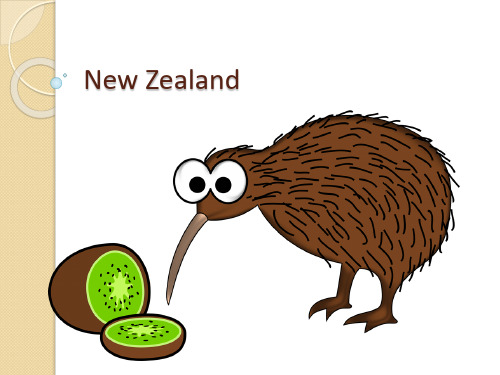
Like Australia, for a long time, New Zealand had followed the policy of Britain and depended on Britain for protection. Yet during and after the Second World War, New Zealand began to shift its allegiance away from Britain toward the United States. In 1951, New Zealand signed the ANZUS Treaty 《澳新美安全条约》with the United
• It has two main islands: North Island and South Island. • Mt Cook: the highest peak, 3,754 meters high; • Lake Taupo: the largest lake, covering 606 sq km; it is 40 km long and 27 km wide. In the surrounding area are numerous geysers and hot springs. ห้องสมุดไป่ตู้ The Clutha: the largest river, 336 km long in the South Island.
The restored Waitangi Treaty House
After 1840 Settlement of New Zealand from the British Isles and Australia began in earnest after the signing of the Treaty of Waitangi. The European population of New Zealand grew from about 1,000 in the 1830s to nearly 60,000 in 1858, and then
英语国家社会与文化
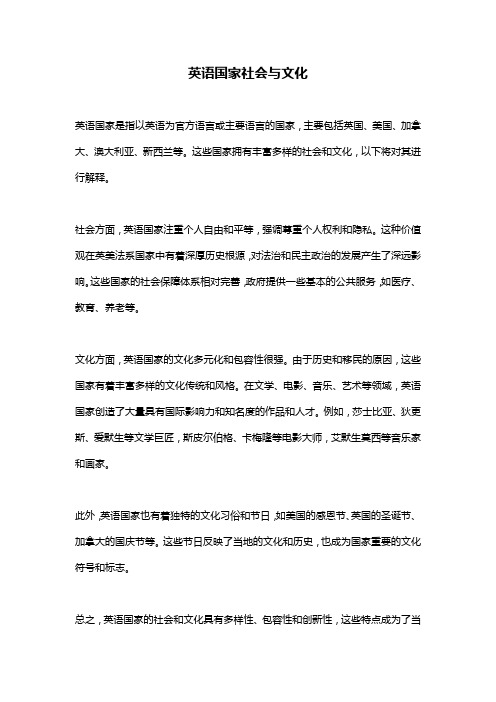
英语国家社会与文化
英语国家是指以英语为官方语言或主要语言的国家,主要包括英国、美国、加拿大、澳大利亚、新西兰等。
这些国家拥有丰富多样的社会和文化,以下将对其进行解释。
社会方面,英语国家注重个人自由和平等,强调尊重个人权利和隐私。
这种价值观在英美法系国家中有着深厚历史根源,对法治和民主政治的发展产生了深远影响。
这些国家的社会保障体系相对完善,政府提供一些基本的公共服务,如医疗、教育、养老等。
文化方面,英语国家的文化多元化和包容性很强。
由于历史和移民的原因,这些国家有着丰富多样的文化传统和风格。
在文学、电影、音乐、艺术等领域,英语国家创造了大量具有国际影响力和知名度的作品和人才。
例如,莎士比亚、狄更斯、爱默生等文学巨匠,斯皮尔伯格、卡梅隆等电影大师,艾默生莫西等音乐家和画家。
此外,英语国家也有着独特的文化习俗和节日,如美国的感恩节、英国的圣诞节、加拿大的国庆节等。
这些节日反映了当地的文化和历史,也成为国家重要的文化符号和标志。
总之,英语国家的社会和文化具有多样性、包容性和创新性,这些特点成为了当
地人民的一种独特魅力,也吸引着世界各地的人们前往探索和体验。
英语国家社会与文化newzealandunit2economy

The Westminster system is a democratic parliamentary system of government modeled after the politics of the United Kingdom. This term comes from the Palace of Westminster, the seat of the Parliament of the United Kingdom.The system is a series of procedures for operating a legislature立法机构. It is used, or was once used, in the national legislatures and sub-national legislatures of most Commonwealth 英联邦and ex-Commonwealth nations upon being granted responsible government, beginning with the first of the Canadian provinces in 1848 and the six Australian colonies between 1855 and 1890.New Zealand(part 2)Part I. Government•What type of government does New Zealand gov ernment belong to?Parliamentary democracy as a sovereign independent state, with a parliamentary government and a constitutional monarchy.Since 1907, the country has been an independent member of the British Commonwealth. Queen Elizabeth II is Queen of New Zealand as well as Britain. She is represented in New Zealand by the Governor-General, who is a New Zealander. Government is drawn from a parliament and headed by a prime minister. Since the 1930s, government has alternated between the National and Labour parties.New Zealand is a constitutional monarchy with a parliamentary democracy. Although it has no codified constitution,the Constitution Act 1986 is the principal formal statement of New Zealand's constitutional structure. Queen Elizabeth II is the head of state and is titled Queen of New Zealand under the Royal Titles Act 1974. She is represented by the Governor-General, whom she appoints on the exclusive advice of the Prime Minister, who is a New Zealander.The Sovereign⏹Queen Elizabeth II is the head of state⏹Her representative is the governor general⏹She has symbolic and ceremonial role and not involved in the day-to-day running of the governmentThe Governor General⏹Appointed by the Sovereign(君主)on the Prime Minster‘s recommendation for a term of 5 yearMain function :ask the leader of the majority Party to form a government; Be able to makeregulations and his of her assent is required for all Bills passed by the House of Representatives before they can become lawParliament⏹two parts the Sovereign 君主and the House of RepresentativesParliament House of Representative⏹The House’s responsibilities: debate and pass legislation; provide a Government; supervise the administration; supply money; represent the views of the people of New Zealand A constitutional monarchy with a parliamentary democracyA constitutional monarchy (a country ruled by a king or queen whose powers are limited by a constitution)Head of state : Queen Elizabeth IIRepresented by Governor-General : Appointed by the queen exclusively under the advice of PM Exercising the Crown’s powers to appoint and dismiss ministers and to dissolve 解散Parliament Chairing 使任职the Executive Council, a formal committee consisting of all ministers of the CrownA constitutional monarchy with a parliamentary democracyA parliamentary democracy 议会民主A parliamentary system is a system of government in which the ministers of the executive branch get their democratic legitimacy from the legislature and are accountable to that body, such that the executive and legislative branches are intertwined.democracy :a system of government in which people vote in elections to choose the people who will govern themOne-chamber ['t ʃeimb ə] Parliament: the House of Representatives ( a government having only one legislative or parliamentary chamber )●PM●Cabinet ●PublicMany parliaments or other legislatures consist of two chambers (or houses): an elected lower house, and an upper house or Senate which may be appointed or elected by a different mechanism from the lower house. This style of two houses is called bicameral.两院制Legislatures with only one house are known as unicameral.一院制120 Members of ParliamentParliamentary general elections: held every three years under a form of proportional representation (比例代表制) called Mixed Member Proportional.PM: the Parliamentary leader of the governing party or coalition联合(of two parties)Cabinet: the most senior policy-making body and led by the PM* Proportional representation is a category of electoral formula aiming at a close match between the percentage of votes that groups of candidates obtain in elections and the percentage of seats they receive.PR is a democratic principle rather than an electoral system in itself. It is often contrasted to "winner takes all" plurality ("first past the post" or FPTP) districts.Yet it may give rise to small and radical political parties, which may decentralize the power of the government.GovernmentMonarch: Queen Elizabeth IIJudiciary system1. The highest court: the Supreme Court of New Zealand:(used to the Privy Council in London)2. the Court of Appeal上诉法院3. The High Court, dealing with serious criminal offences and civil matters at the trial level and with appeals from lower courts and tribunals法院4. Subordinate courtsseparation of powers (the executive, legislative and judicial powers) checks and balances1.1 The Executive BranchThe Governor-General exercises the Crown's prerogative powers, such as the power to appoint and dismiss ministers and to dissolve Parliament, and in rare situations, the reserve powers. The Governor-General also chairs the Executive Council, which is a formal committee consisting of all ministers of the Crown. Members of the Executive Council are required to be Members of Parliament, and most are also in Cabinet. Cabinet is the most senior policy-making body and is led by the Prime Minister, who is also, by convention, the Parliamentary leader of the governing party or coalition.1.2 The Legislative BranchThe New Zealand Parliament has only one chamber, the House of Representatives, which usually seats 120 Members of Parliament. Parliamentary general elections are held every three years under a form of proportional representation called Mixed Member Proportional. The 2008 General Election created an 'overhang' of two extra seats, occupied by the Māori Party, due to that party winning more seats in electorates than the number of seats its proportion of the party vote would have given it.From October 2005 until November 2008, the Labour-led government was in formal coalition with the Progressive Party, Jim Anderton being its only MP. In addition, New Zealand First and United Future provided confidence and supply in return for their leaders being ministers outside cabinet. An arrangement was also made with the Green Party, which gave a commitment not to vote against the government on confidence and supply. In 2007 Labour also had the proxy vote of Taito Phillip Field, a former Labour MP. These arrangements assured the government of a majority of seven MPs on confidence votes.Labour was defeated by the National Party in the general elections of November 8, 2008. Following the victory, National leader John Key moved quickly to form a government, negotiating coalition agreements with the right-wing ACT party, led by Rodney Hide, the centrist United Future party, albeit with its single seat held by leader Peter Dunne, and the Māori Party, led by Tariana Turia and Pita Sharples. Each of these leaders are to hold ministerial posts but remain outside of Cabinet. There are to be three parties in Opposition: the Labour Party, led by Phil Goff; the Greens, co-led by Jeanette Fitzsimons and Russel Norman and the Progressive Party, under Jim Anderton. The new executive was sworn in on 19 November 2008.1.3The Judicial BranchThe highest court in New Zealand is the Supreme Court of New Zealand, established in 2004 following the passage of the Supreme Court Act 2003. The act abolished the option to appeal to the Privy Council in London. The current Chief Justice is Dame Sian Elias. New Zealand's judiciary also includes the Court of Appeal; the High Court, which deals with serious criminal offences and civil matters at the trial level and with appeals from lower courts and tribunals; and subordinate courts.New Zealand is the only country in the world in which all the highest offices in the land have been occupied simultaneously by women: Queen Elizabeth II, Governor-General Dame Silvia Cartwright, Prime Minister Helen Clark, Speaker of the House of Representatives Margaret Wilson and Chief Justice Dame Sian Elias were all in office between March 2005 and August 2006. New Zealand's largest listed company, Telecom New Zealand, had a woman - Theresa Gattung - as its CEO at the time.6.Local Government⏹Independent of the central government⏹Constitutional subordinate to the parliament⏹Confers the powers of local authoritiesLocal government and external territoriesOnce divided New Zealand into provinces before 1876Centralized government:No sub-national entities such as provinces, states or territories, apart from its local government Local government: administering the various regions of New ZealandLocal government re-organised in 1989 implementing the current two-tier structure of regional councilsThe Local GovernmentThe early European settlers divided New Zealand into provinces. These were abolished in 1876 so that government could be centralised, for financial reasons. As a result, New Zealand has no separately represented subnational entities such as provinces, states or territories, apart from local government. However the spirit of the provinces lives on, and there is fierce rivalry exhibited in sporting and cultural events. Since 1876, local government has administered the various regions of New Zealand. In 1989, the government completely reorganised local government, implementing the current two-tier structure of regional councils and territorial authorities constituted under the Local Government Act 2002. In 1991, the Resource Management Act 1991 replaced the Town and Country Planning Act as the main planning legislation for local government.New Zealand has 12 regional councils for the administration of regional environmental and transport matters and 73 territorial authorities that administer roading, sewerage, building consents, and other local matters. The territorial authorities are 16 city councils, 57 district councils, and the Chatham Islands County Council. Four of the territorial councils (one city and three districts) and the Chatham Islands County Council also perform the functions of a regional council and are known as unitary authorities. Territorial authority districts are not subdivisions of regional council districts, and a few of them straddle regional council boundaries.The regions are (asterisks denoteunitary authorities): Northland, Auckland,Waikato, Bay of Plenty, Gisborne*,Hawke's Bay, Taranaki,Manawatu-Wanganui, Wellington,Marlborough*, Nelson*, Tasman*, WestCoast, Canterbury, Otago, Southland,Chatham Islands*.As a major South Pacific nation, New Zealand has a close working relationship with many Pacific Island nations, and continues a political association with the Cook Islands, Niue and Tokelau. New Zealand operates Scott Base in its Antarctic territory, the Ross Dependency. Other countries also use Christchurch to support their Antarctic bases and the city is sometimes known as the "Gateway to Antarctica".Part II. EconomySection I An IntroductionNew Zealand has a market economy with sizeable manufacturing and service sectors complementing a highly efficient export-oriented agriculture sector.•In the 1980s and 1990s: underwent radical economic restructuring (removal of subsidiaries, tariffs and price controls, the floating of the exchange rate, the abolition of controls on capital movement, the privatization of many state assets)•Over the past 80 years: a substantial reduction on the share of agriculture in GDP•Over the past 20 years: an uneven expansion of the service sector•Over 2002 to 2004: growth in GDP in the range of 3.5% to 4.5%•Over 2006:CPI inflation increased to 4.0%(June), 3.5%(September), 2.6%(December)•Over 2007: the annual current account deficit 9.1% of GDPA large proportion of the risks and uncertainties concerning the outlook for the New Zealand economy revolve around domestic or New Zealand-specific factors.Section II Primary IndustriesPrimary industries generate much of NZ’ s wealth. Agriculture , horticulture, forestry and fishery account for over 60% of exports.Agriculture and Horticulture: NZ is known as the world’s largest farm, agriculture accounts for 4.6% of GDP, horticulture crops have become increasing important.Dairy, sheep, beef cattle, deer, goats, pigs, poultry, bee-keeping, apple and kiwifruitForest: heavily forested, a quarter as conservation areas.Radiate pine, Douglas firFishery: vital to NZ’ s life, a long coastline and EEZ of 3.1millionSquid, tuna, green-lipped mussels, mackerel, rock lobster and abaloneSection III Secondary Industries1. ManufacturingMake an important contribution to the national economy;The largest sub-sectors are food, beverages and tobacco, machinery and equipment;Building new homes is significant, residential construction is 60%;CER and NAFTA.Energy and MineralsHas significant natural energy resources, with good reserves of coal, natural gas and oil, extensive geothermal fields;After 1973, oil and gas exploration was increased and energy conservation programs developed and promoted.Section IV Tertiary IndustriesTransport and CommunicationTourismTrade1. Transport and CommunicationTransport•Shipping: important, 99% of exports, Auckland is the largest port, the vital transport link (from Wellington in the North Island to Picton in the South Island)•By air: 17% of exports by value, Auckland is the second largest port for imports, a favored form of domestic business and travel•Car: the most popular form, 73% of NZers drove to work•Railway : not play the central role now, major haulers of long-distance freightcommunication•Radio: a great range of private stations (Maori tribal stations)•Television•Telephone: over 95% have one, half have mobile phone and access to the internet•ICT: thriving2. Tourism•Plays a significant role 4.8% of GDP•Gorgeous beaches, spectacular geothermal, volcanic activity•World-leading museums, groomed ski slopes•The America’s Cup yachting competitio n, the locally made movie The Lord of the Rings3. Trade•Exporting:Horticulture: cut flowers, kiwifruit, apples, vegetables, winesThe old standbys: wool ,butter and cheeseThe manufacturing: whiteware (fridges and dishwashers), electric fences, newsprint and furniture•Importing: meat and dairy products•Export destinations:Australia, America, Japan, China, BritainNew Zealand has a market economy which is greatly dependent on international trade, mainly with Australia, the European Union, the United States, China, and Japan. It has only small manufacturing and high-tech sectors, being strongly focused on tourism and primaryindustries like agriculture. New Zealand is a country heavily dependent on trade, particularly in agricultural products. Exports account for around 24% of its output, which is a relatively high figure.This makes New Zealand particularly vulnerable to international commodity prices and global economic slowdowns. Its principal export industries are agriculture, horticulture, fishing and forestry.Its major export partners are Australia 20.5%, US 13.1%, Japan 10.3%, China 5.4%, UK 4.9% (2006).Traditionally, New Zealand's economy was built upon on a narrow range of primary products, such as wool, meat and dairy productsAgriculture - Products: wheat, barley大麦, potatoes, pulses豌豆和豆类, fruits, vegetables; wool, beef, dairy products; fishExports - commodities: dairy products, meat, wood and wood products, fish, machineryImports - commodities:machinery and equipment, vehicles and aircraft, petroleum, electronics, textiles, plasticsAgriculture in New Zealand is the largest sector of the tradeable economy, contributing about two-thirds of exported goods in 2006-7.[1] For the year ended March 2002, agricultural exports were valued at over $14.8 billion. The New Zealand agricultural sector is unique in being the only developed country to be totally exposed to the international markets since subsidies, tax concessions and price supports were removed in the 1980s.[2] Pastoral farming is the major land use but there are increases in land area devoted to horticulture.花园种植1) AgricultureIn the past, the agricultural sector emphasized on sheep raising.Nowadays, dairying, forestry, horticulture become more important.•New Zealand sometimes called “the world’s biggest farm”and it is the world’s largest exporter of lamb and mutton and dairy products. Farms are very much family business.•New Zealand is one of the world’s largest exporters of meat, dairy products and wool. The main imports are industrial raw materials, capital equipment and consumer goods.The tertiary sector is the largest sector in the economy (68.8% of GDP), followed by the secondary sector (26.9% of GDP) and the primary sector (4.3% of GDP).Tourism ,forestry, horticulture, fishing and manufacturing have become increasing important sectors in the economy in recent years.The tertiary sector is the largest sector (67.6% of GDP)Secondary sector on 27.8%Primary sector on 4.7%Tourism plays a significant role in New Zealand's economy. Tourism contributes $12.8 billion (or 8.9%) to New Zealand’s total GDP and supports 9.9% of the total workforce in New Zealand.EconomyNew Zealand has a modern, prosperous, developed economy with an estimated nominal Gross domestic product (GDP) of US$128.1 billion (2008). The country has a relatively high standard of living with an estimated GDP per capita of US$30,234 in 2008, comparable to Southern Europe, e.g. Spain US$33,385, but lower than the United States at US$46,820.Since 2000 New Zealand has made substantial gains in median household income. New Zealand, along with Australia, largely escaped the early 2000s recession that affected most other Western countries. New Zealand's GDP declined by 0.2% in the second quarter of 2008 putting the country in its first recession in a decade.New Zealanders have a high level of life satisfaction as measured by international surveys; this is despite lower GDP per-head levels than many other OECD countries. The country was ranked 20th on the 2006 Human Development Index and 15th in The Economist's 2005 worldwide quality-of-life index. The country was ranked 1st in life satisfaction and 5th in overall prosperity in the 2007 Legatum Institute prosperity index.In addition, the 2007 Mercer Quality of Living Survey ranked Auckland 5th place and Wellington 12th place in the world on its list. Taxation in New Zealand is lighter than in other OECD countries. New Zealand is one of the most free market capitalist economies according to economic freedom indices.The service sector is the largest sector in the economy (68.8% of GDP), followed by manufacturing and construction (26.9% of GDP) and the farming/raw materials extraction (4.3% of GDP).New Zealand is a country heavily dependent on free trade, particularly in agricultural products. Exports account for around 24% of its output, which is a relatively high figure (it is around 50% for many smaller European countries). This makes New Zealand particularly vulnerable to international commodity prices and global economic slowdowns. Its principal export industries are agriculture, horticulture, fishing and forestry. These make up about half of the country's exports. Its major export partners are Australia 20.5%, US 13.1%, Japan 10.3%, China 5.4%, UK 4.9% (2006). Tourism plays a significant role in New Zealand's economy. Tourism contributes $12.8 billion (or 8.9%) to New Zealand’s total GDP and supports nearly 200,000 full-time equivalent jobs (9.9% of the total workforce in New Zealand). Tourists to New Zealand are expected to increase at a rate of 4% annually up to 2013.The New Zealand dollar is the currency of New Zealand. It also circulates in the Cook Islands , Niue, Tokelau, and the Pitcairn Islands. It is sometimes informally known as the "Kiwi dollar".Part III Education•Education in New Zealand is compulsory between the ages of 6 and 16, and the tuition in state schools is free to New Zealand residents.•An elected board of trustees governs each school.•One of the most successful programmes is Te Kohanga Reo (language “nest”) —centres of learning for pre-school Maori children. Pacific Island language programmes have also been established, particularly in Auckland.Education systemPrimary School (5-11, or 5-13)•Infant School (5-7, 2 years)•Standards 1 to 4 (7-11, 4 years)•Forms 1 and 2 (11-13) in some schoolsSeparate Intermediate Schools (11-13)•Forms 1 and 2Secondary schools (13-18, colleges or high schools)•Forms 3-7 ( 5 years)•In the larger cities, state schools may beco-educational or single-sex; in smaller centers, they are usually co-educational. Private schools are often single-sex, and usually have a religious affiliation.•There are 2 types of state examination available to state and private secondary schools: School Certificate and University Bursaries and Entrance Scholarship.•quality education: secondary education, English language training or further and technical education•provider of qualified teachers•Universities in New Zealand:•an international reputation as a provider of quality education•a safe learning environment•excellent study opportunities and support services for international students •internationally respected for their academic and research standards•a high level of research activity recognized internationallyThe World’s Biggest Farm [•Why is New Zealand called “the world’s biggest farm”?•1) It has an ideal climate for grassland farming. There are about 59,000 farms and businesses growing flowers, fruit and vegetables.•2) New Zealand is the world’s largest exporter of lamb and mutton.•3) It is also the world’s largest exporter of dairy products.•4) It is one of the world’s largest exporters of meat.59,000 Farms with 68 Million Sheep Living Outside All the Year RoundA Typical Welfare State [•As a comprehensive welfare state, which of the following items is not included in its welfare system?•(A) Education is freely available to everyone. Nearly all the schools are run by the state. All the public schools are free and religion is taught.•(B) A ministry of women's affairs was established in 1985, probably the earliest of such a ministry in the world.•(C) Treatment at public hospitals is free, as are pre-birth and maternity services and most prescription medicines. A percentage of doctors' fees is paid by the state.•(D) People on low incomes get reduced fees and medicine costs with their community services card. The Accident Compensation Corporation provides immediate benefits of free medical treatment for everyone who suffers personal injury by accident.•[A]Ⅰ.New Zealand’s Constitution⏹No written form⏹Constitutional conventions:drawn from important statutes ,judicial decisions,and customary rules;eatablished by frequent use and customⅢ.Judiciary and Party Politics1.Judicial syetem1)Law Common lawStatute lawUnited Kingdom statute lawSubordinate legislation2)Courts⏹District Courts⏹The High Court⏹The Court of Aooeal⏹The Supreme Court2.Political Parties1)An Introduction⏹22 registered political partied⏹Two major political partiesThe National Party(on the right)The Labor Party(on the left)2)The National Party⏹Formed in Wellington in May 1936⏹Represent all parts of the community⏹Proposals:a.Seeks a safe,prosperous and successful New Zealandb.Creates opportunities for all New Zealanders to reach their personal goals anddreamsc.Individual responsibility ,private enterprise and reward for individual efforts3)The Labor Party⏹Founded in 1916⏹The longest eatablished political party⏹Introduced radical and progressive measures that contributed to the steady improvement and ultimate transformationPolitics of New ZealandThe politics of New Zealand take place in a framework of a parliamentary representative democratic monarchy. The basic system is closely patterned on that of the Westminster System, although a number of significant modifications have been made. The head of state is Queen Elizabeth II, who is represented by the Governor-General and the head of government is the Prime Minister who chairs the Cabinet drawn from an elected Parliament.ConstitutionNew Zealand has no formal codified constitution; the constitutional framework consists of a mixture of various documents (including certain acts of the United Kingdom and New Zealand Parliaments), the Treaty of Waitangi and constitutional conventions. The Constitution Act in 1852 established the system of government and these were later consolidated in 1986. Constitutional rights are protected under common law and are strengthened by the Bill of Rights Act 1990 and Human Rights Act 1993, although these are not entrenched and can be overturned by Parliament with a simple majority.[1] The Constitution Act describes the three branches of Government in New Zealand: The Executive (the Sovereign and Cabinet), the legislature (Parliament) and the judiciary (Courts).ExecutiveHead of StateQueen Elizabeth II is the current Queen of New Zealand and the Realm of New Zealands head of state.[2][3] The New Zealand monarchy has been distinct from the British monarchy since the Statute of Westminster Adoption Act 1947, and all Elizabeth II's official business in New Zealand is conducted in the name of the Queen of New Zealand, not the Queen of the United Kingdom. While Royal Assent and the royal sign-manual are required to enact laws, letters patent, andOrders-in-Council, the authority for these acts stems from the New Zealand populace.[4] In practice, the functions of the monarchy are conducted by the Governor-General, appointed by the monarch on the advice of the Prime Minister. As of 2011, the Governor-General is Sir Jerry Mateparae. The Governor-General's powers are primarily symbolic and formal in nature. The Governor-General formally has the power to appoint and dismiss Prime Ministers and to dissolve Parliament; and also formally signs legislation into law after passage by Parliament. The Governor-General chairs the Executive Council, which is a formal committee consisting of all ministers of the Crown. Members of the Executive Council are required to be Members of Parliament, and most are also in Cabinet.[5]Head of GovernmentCabinet is the most senior policy-making body and is led by the Prime Minister, who is also, by convention, the Parliamentary leader of the governing party or coalition, and is known as the head of government. The New Zealand Cabinet is responsible to New Zealand Parliament from which its members are derived. All Cabinet Ministers must be Members of Parliament (MPs) and are collectively responsible to it.General elections are held every three years, with the last one in 2008 and the next due for 2011. National won the 2008 election ending nine years of Labour led Government. National leader John。
《英语国家社会与文化入门》(第3版)(朱永涛、王立礼主编)(考研真题与典型题详解 美国政治制度、教育
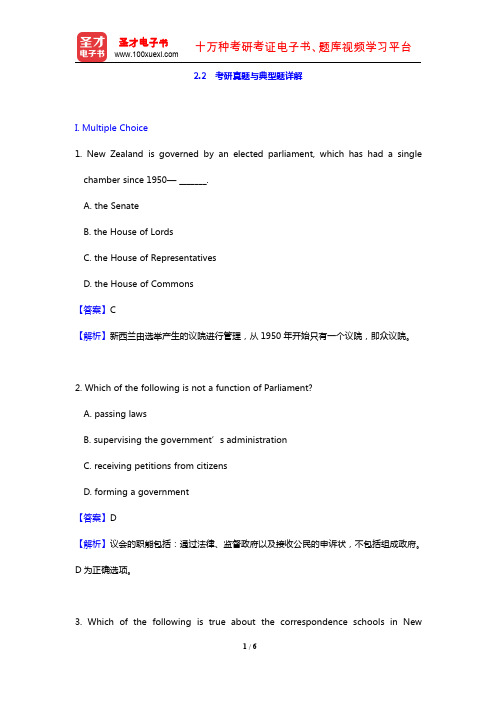
2.2考研真题与典型题详解I.Multiple Choice1.New Zealand is governed by an elected parliament,which has had a single chamber since1950—_______.A.the SenateB.the House of LordsC.the House of RepresentativesD.the House of Commons【答案】C【解析】新西兰由选举产生的议院进行管理,从1950年开始只有一个议院,即众议院。
2.Which of the following is not a function of Parliament?A.passing lawsB.supervising the government’s administrationC.receiving petitions from citizensD.forming a government【答案】D【解析】议会的职能包括:通过法律、监督政府以及接收公民的申诉状,不包括组成政府。
D为正确选项。
3.Which of the following is true about the correspondence schools in NewZealand?A.They provide distance education.B.The tuition is free.C.They are often not co-educational.D.They mainly teach religion courses.【答案】A【解析】函授学校是新西兰最大的学校,为学生提供远程教育,每天上课的内容都按照新西兰的教学大纲。
A为正确选项。
Ⅱ.Fill in the blanks.1.The Head of State of New Zealand is_______,represented in New Zealand by a Governor-General.【答案】the British monarch【解析】新西兰的国家元首是英国女王,总督是她在新西兰的代表。
新西兰(英语社会文化课课件)
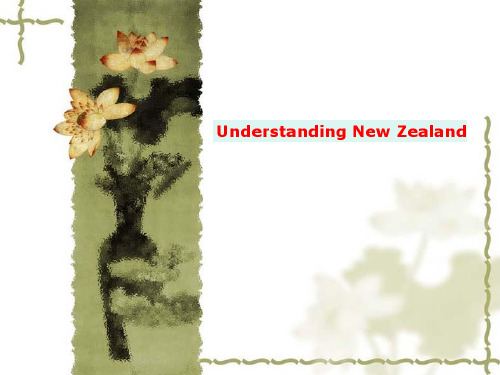
English and Maori are the official languages of New Zealand. Maori became an official language in 1987.New Zealand English is close to Australian English in pronunciation, but has several subtle differences.
Political System
The politics of New Zealand takes place in a framework of a parliamentary representative democratic monarchy.
Currency
The New Zealand dollar (currency code NZD)is the currency of New Zealand. It is normally abbreviated with the dollar sign $, or alternatively NZ$ to distinguish it from other dollar-denominated currencies.
Cliocated in the Southern Temperate Zone, south of the tropics. It has a mild climate with four seasons. The warmest months of summer are January and February and the coldest months of winter are June and July.
【英语国家社会与文化】New Zealand
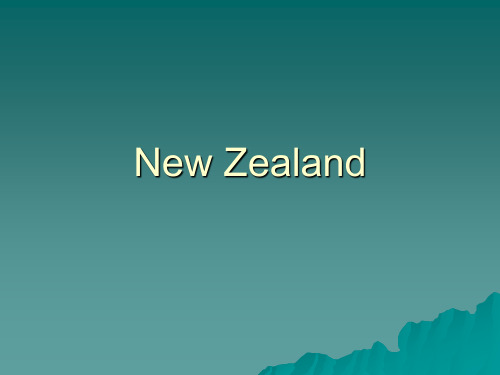
City
What
is the capital of New Zealand? Auckland, Wellington Wellington (P4) the southernmost and windiest capital city in the world
Climate
January
and February are its warmest months and July is normally its coldest. What is the season of Christmas? They celebrate their Christmas in mid-summer.
People (P6)
gold
boom in the South Island the North Island Auckland the home to more than a quarter of the population
Questions
Composition
of population 80% 15% 5% Some ethnic groups are from the Pacific Islands, about _____. Among them, _____ are of white, European descent. The Maoris, who first arrived on the island over 1,000 years ago, make up _____.
New Zealand
The North Island rivers, lakes, geysers, and hot springs The South Island wide, flat, more extensive lowlands An area of outstanding scenic beauty
【英语国家社会与文化】New Zealand (b)
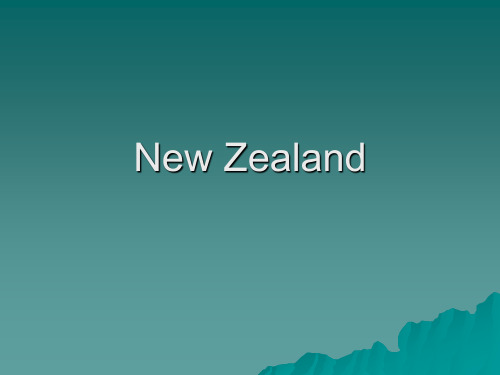
New Zealand was the first sovereign to give women the right to vote in 1893. The USA --- 1920
Government
Government
Parliament House of Representative
The Legislature
Political Parties
III Government
The Executive
PM
The Judiciary
Cabinet Public Sector
Parliamentary election
New Zealand as a Realm
1983, dominion --- realm midmid-1980s declared its antinuclear policy mid-1980s—midmid-1980s—mid-1990s radical economic reforms a unique blend of South Pacific and European cultures with a strong national identity of its own
New Zealand as a Colony
What is the Treaty of Waitangi? In 1840 between Maoris and the British government The anniversary of the signing, February 6 becomes the National Day. Land Maoris ---- the possession of land The Queen of Britain ----- complete governance of the islands
新西兰的历史和文化的英语作文
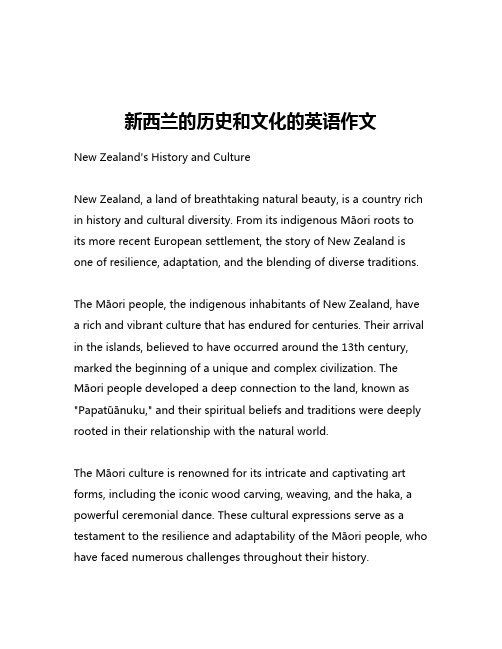
新西兰的历史和文化的英语作文New Zealand's History and CultureNew Zealand, a land of breathtaking natural beauty, is a country rich in history and cultural diversity. From its indigenous Māori roots to its more recent European settlement, the story of New Zealand is one of resilience, adaptation, and the blending of diverse traditions.The Māori people, the indigenous inhabitants of New Zealand, have a rich and vibrant culture that has endured for centuries. Their arrival in the islands, believed to have occurred around the 13th century, marked the beginning of a unique and complex civilization. TheMāori people developed a deep connection to the land, known as "Papatūānuku," and their spiritual beliefs and traditions were deeply rooted in their relationship with the natural world.The Māori culture is renowned for its intricate and captivating art forms, including the iconic wood carving, weaving, and the haka, a powerful ceremonial dance. These cultural expressions serve as a testament to the resilience and adapt ability of the Māori people, who have faced numerous challenges throughout their history.One of the most significant events in New Zealand's history was the signing of the Treaty of Waitangi in 1840. This document, negotiated between the British Crown an d Māori chiefs, established the basis for the country's bicultural foundation. The treaty recognized the rights of the Māori people and their sovereignty, while also paving the way for British settlement and the eventual establishment of New Zealand as a dominion of the British Empire.The arrival of European settlers, particularly from Britain, marked a significant transformation in New Zealand's history. These settlers brought with them new technologies, agricultural practices, and architectural styles, which gradually blended with the existing Māori traditions. This process of cultural exchange and integration has continued to shape the unique identity of New Zealand.One of the hallmarks of New Zealand's cultural landscape is its vibrant and diverse ar ts scene. From the renowned Māori performing arts to the thriving contemporary art movement, the country has produced a wealth of talented artists, writers, and musicians who have gained international recognition. The country's natural beauty has also been a source of inspiration for many creative individuals, with the stunning landscapes and seascapes serving as a backdrop for their work.In addition to its rich cultural heritage, New Zealand is also knownfor its stunning natural environment. The country's diverse landscapes, ranging from rugged mountain ranges to pristine beaches and lush rainforests, have made it a popular destination for outdoor enthusiasts and nature lovers. The country's commitment to environmental conservation and sustainable practices has also played a significant role in preserving its natural wonders for future generations.The story of New Zealand's history and culture is one of resilience, adaptation, and the blending of diverse traditions. From the indigenous Māori people to t he more recent European settlers, the country has evolved into a unique and vibrant society that celebrates its diversity and its connection to the natural world. Whether exploring its rich cultural heritage, marveling at its stunning natural beauty, or engaging with its thriving arts scene, there is much to discover and appreciate in the land of the long white cloud.。
新西兰社会文化介绍英文版200字

新西兰社会文化介绍英文版200字Compared with other countries, New Zealanders have a high quality of life, and their food, clothing, housing, transportation and other aspects also attract much attention, and people pay great attention to the small details of their life.They also have a very good habit, all like outdoor sports, which also makes them have a good physique, their favorite sports dare not say, but more like or a lot of, there are horse racing, rugby competition.In New Zealand countries, some ethnic groups still have retained the ethnic customs handed down since ancient times.Many of them believe in polytheism, which is a very primitive religion.They thought that the soul would not be shattered, and that people should respect the elves of their ancestors.Every time there is a big event in China, they go to the river to pray and pour water on each other in this way to express the purity of religious rituals.In addition, the locals are used to eating English dishes, the food taste is light, they like to drink mostly black tea or coffee, and very healthy is, they like and often eat fruit, a fruit is very popular withthem, and the fruit is relatively expensive.In New Zealand, you will always feel the existence of Maori culture. Maori people are born artists, and Maori culture is the original ecological culture that New Zealand pays special attention to and protection.According to anthropologists, the Maori people, formerly Asian residents, migrated across the sea to the Polynesian Islands in the South Pacific in the 3rd century.。
高一英语必修四知识点重点解析:NewZealand
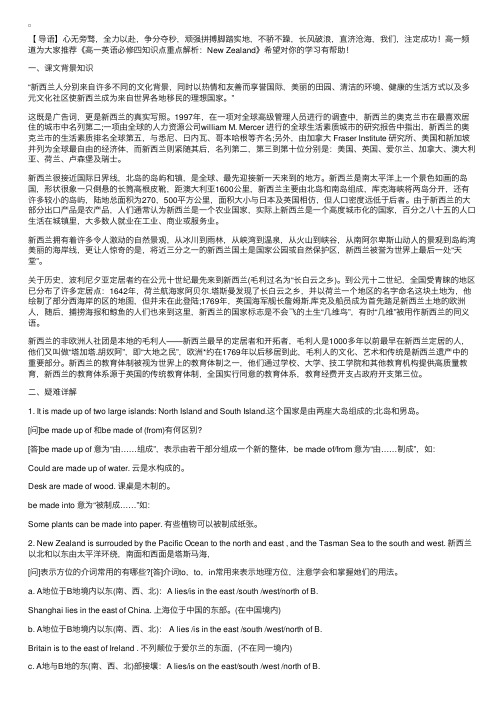
【导语】⼼⽆旁骛,全⼒以赴,争分夺秒,顽强拼搏脚踏实地,不骄不躁,长风破浪,直济沧海,我们,注定成功!⾼⼀频道为⼤家推荐《⾼⼀英语必修四知识点重点解析:New Zealand》希望对你的学习有帮助!⼀、课⽂背景知识“新西兰⼈分别来⾃许多不同的⽂化背景,同时以热情和友善⽽享誉国际,美丽的⽥园、清洁的环境、健康的⽣活⽅式以及多元⽂化社区使新西兰成为来⾃世界各地移民的理想国家。
”这既是⼴告词,更是新西兰的真实写照。
1997年,在⼀项对全球⾼级管理⼈员进⾏的调查中,新西兰的奥克兰市在最喜欢居住的城市中名列第⼆;⼀项由全球的⼈⼒资源公司william M. Mercer 进⾏的全球⽣活素质城市的研究报告中指出,新西兰的奥克兰市的⽣活素质排名全球第五,与悉尼、⽇内⽡、哥本哈根等齐名;另外,由加拿⼤ Fraser Institute 研究所、美国和新加坡并列为全球最⾃由的经济体,⽽新西兰则紧随其后,名列第⼆,第三到第⼗位分别是:美国、英国、爱尔兰、加拿⼤、澳⼤利亚、荷兰、卢森堡及瑞⼠。
新西兰很接近国际⽇界线,北岛的岛屿和镇,是全球、最先迎接新⼀天来到的地⽅。
新西兰是南太平洋上⼀个景⾊如画的岛国,形状很象⼀只倒悬的长筒⾼根⽪靴,距澳⼤利亚1600公⾥,新西兰主要由北岛和南岛组成,库克海峡将两岛分开,还有许多较⼩的岛屿,陆地总⾯积为270,500平⽅公⾥,⾯积⼤⼩与⽇本及英国相仿,但⼈⼝密度远低于后者。
由于新西兰的⼤部分出⼝产品是农产品,⼈们通常认为新西兰是⼀个农业国家,实际上新西兰是⼀个⾼度城市化的国家,百分之⼋⼗五的⼈⼝⽣活在城镇⾥,⼤多数⼈就业在⼯业、商业或服务业。
新西兰拥有着许多令⼈激动的⾃然景观,从冰川到⾬林,从峡湾到温泉,从⽕⼭到峡⾕,从南阿尔卑斯⼭动⼈的景观到岛屿湾美丽的海岸线,更让⼈惊奇的是,将近三分之⼀的新西兰国⼟是国家公园或⾃然保护区,新西兰被誉为世界上最后⼀处“天堂”。
关于历史,波利尼⼣亚定居者约在公元⼗世纪最先来到新西兰(⽑利过名为“长⽩云之乡)。
- 1、下载文档前请自行甄别文档内容的完整性,平台不提供额外的编辑、内容补充、找答案等附加服务。
- 2、"仅部分预览"的文档,不可在线预览部分如存在完整性等问题,可反馈申请退款(可完整预览的文档不适用该条件!)。
- 3、如文档侵犯您的权益,请联系客服反馈,我们会尽快为您处理(人工客服工作时间:9:00-18:30)。
Environmental Issues
Introduced animals have seriously affected native fauna and their habitat.(外来物种的生物入侵) New Zealander’s environmental awareness is reflected in legislation. In 1991, the Resource Management Act(资源管理法) came into effect. It was the first piece of environmental legislation of its kind in the world.
Local Government
• There are three levels of local government, and a ratepayer may deal with all three in everyday life. • Regional councils(地方民防) have an environmental overview and are responsible for resourse management. • Territorial authorities(土地局) are City Councils, District Councils and the Chatham Island Country Council. • Community boards(社区委员会) promote local community interests and may have other powers than the local government give them.
Maoritanga
(毛利文化)
• Maoritanga means “Maori culture”, and one in seven people identify themselves as New Zealand Maori. Maori people today have adopted many aspects of western life, and Maori business make up one of the most important parts of the private sector. At the same time, many Maori sustain their own unique culture.
The New Zealanders
• Most New Zealanders (about 86%) live in cities and towns, and about 75%live in the northern Island. Much of the country is too much mountainous for people to live. • Around 80% of the New Zealanders identify themselves as having European ancestry. The next largest population group are Maori, 15% in 2006. people from the Pacific Island made up about 7% of the population in 2006. 碰鼻礼
History
• New Zealand ——Aotearoa, “land of the long white cloud” —— was settled over 100 years ago by voyagers from East Polynesia. • These settlers, the forebears of today’s Maori, lived in tribes based on family networks. By 1200, they had settled in the North Island and the South Island. • The first European navigators arrived in 1642. • The Treaty of Waitangi(怀唐伊条约)was an instrument designed to bring law and order in trading settlements and to protect Maori rights in dealings with the settlers. • Settler society boomed after the gold rusher from the 1860s. Economic depression in the 1880s produced social and economic change. Worldwide economic depression hits New Zealand in the late 1920s.
The Alps
• It is a small country with a small population, a long way from the large powerful countries, but many people know about New Zealand. • It has an interesting geological (地质学的) history. • Its government and people speak out against nuclear weapon. • The first country where women could vote for a new government. • Maori people. • A lot of tourists go to New Zealand and enjoy holidays.
Auckland
Government
• New Zealand is an independent state, governed by a democratically elected parliament. New Zealand has no written constitution. The head of state is the British monarch Queen Elizabeth Ⅱ in her capacity as Queen of New Zealand, represented by a Governor-General. • There are currently(2008 election) 122 Members of Parliament(MPs), who are all elected. Seven of these are Maori MPs. • The parliamentary election in 1996 was held for the first time under the proportional representation system as MMPR(混合比例代表制). MMPR offers an opportunity for a range of parties to gain seats by achieving at least 5%of the party vote.
Economy
• Agriculture New Zealand is a rugged country, with little flat, naturally arable land, and its reputation as the world’s largest farm has been the result of hard work. New Zealand’s climate allows almost all livestock to remain outside all year round. • Forestry & Fishing Forest cover more than a quarter of New Zealand. Forest products are important earners of oversea funds. • Energy New Zealand is largely self-sufficient in energy. Fast-flowing rivers provides about 60% of the nation’s electricity. • Overseas Trade New Zealand lives by trade.
Real mediaeval age’s world
真实的中古世界
Geography and Land
• New Zealand is a large, long group of island, 2000 kilometers from north from to south. • A huge diversity of physical geography has produced a wide variation in landscape.(多样的自然 景观)The North Island: volcanoes(火山), ski fields(滑 雪场), thermal region(温泉区), and so on. The South Island: the Southern Alps. • Unique flora and fauna(独特的动物群植物群)
Education
• Education in New Zealand is compulsory between the ages of 6 and 16, and tuition in state school is free to New Zealand resident. • The largest school in New Zealand, the Correspondence School(函授学校), provides distance education for students from early childhood upwards. • There are nine universities in New Zealand: Auckland, Auckland University of Technology, Canterbury, Lincoln, Massey, Otaቤተ መጻሕፍቲ ባይዱo, Victoria, Waikato, and one Maori university, Te Wananga o Antearoa.
